|
|
||||
| SAUCIER+PERROTTE. Collège Gérald-Godin |
||||
| [in italiano] | Adjacent to the Rivière-des-Prairies, the former Jesuit monastery has a commanding presence in the village of Sainte-Geneviève. The "Lombard" style building constructed in 1933 by architect Lucien Parent was chosen to house the new French College at the western extremity of the island of Montreal. The concrete building is wrapped with a local stone veneer and is situated on a small hill in 3.5 hectares of gently sloping landscape, including a peninsula stretching north into the Rivière-des-Prairies. |
[18mar2001] | ||

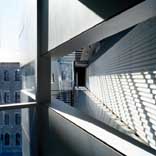 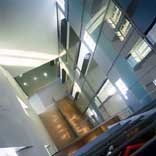
|
 The building has two lateral wings that define a covered cloister with the former bell tower overlooking. The imposing nature of the old monastery and the beauty of the site suggested using the landscape to insert an imaginary archaeology. The new building is sited to respect the configuration of this superimposed layer in plan and section. |
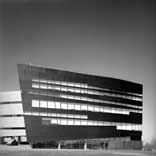   |
||
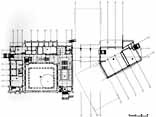   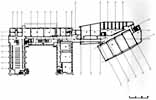 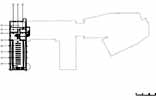 |
The change of function represents the third life for the monastery, and is a demanding transformation. The college program offers a diversity of functions related to education: classrooms, laboratories, sports facility, library, professor's offices and administration, as well as a multi-functional theatre seating 350 that will be open to the public.  The classrooms and laboratories detach themselves as though suspended over the excavated ground. The sports facility and the theatre find themselves below ground defining a north-south axis towards the river. This axis, which is also perceptible above ground, provokes a rupture in the new building and opens a passage towards a belvedere suspended over the theatre and the shore of the river. A transverse section of the site illustrates well the different possibilities of this composition. Near the shore of the river, the theatre opens up onto an exterior stage where the terrain is seemingly being eroded by the action of the water. The two skylights, jutting from the ground like cannons, illuminate the foyer of the theatre and enable us to identify the presence of an invisible subterranean world. |
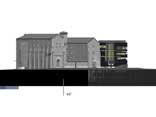 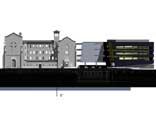 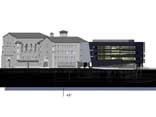    
|
||
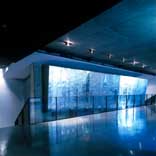  |
The coloured lighting and fibreglass envelope of the classrooms and laboratories strongly define this volume, perceptible from the exterior through the sliced and stretched aluminium skin enveloping the new complex. The cafeteria at ground floor becomes a physical connection between the new archaeological landscape and the volume of the laboratories above. The uneven topography permits a terraced area opening onto the gently sloped terrain towards the river. With this formal and material presence the new building emerges from the ground to complement the existing monastery, and defines its own identity. The existing walls and finishes of the monastery will be stripped and replaced by walls that provide a more open design. This open space planning contributes to the value of the interior courtyard and the east-west axis that merges the new building with the college library situated in the former chapel. Slots in the floor slabs contribute to the spacious character of the complex. The new materials are juxtaposed with the existing building without encroaching on its character. Emerging from the landscape like the spirit of the past, the building reorients the site to the rich knowledge that lays buried in the subterranean world. Saucier+Perrotte Architects spa@saucierperrotte.com |
|||

|
Since 1988, the work of
SAUCIER+PERROTTE
has concentrated primarily on the realization of cultural buildings in the evolving contemporary city. The work has since extended into other typologies while retaining the important primary notion of "urban scenography" that pervades all of their projects to date. The firm's method is a research based "essai" to achieve a spatial simplicity by which materials exert the force of their intrinsic physical and poetic qualities. The most recent investigations endeavor to reveal the essential relationships between materials, colour and landscape, and to accentuate the expressive potential unique to each. Recognized and appreciated by organizations both public and private, the firm has been invited to participate in several national and international architectural competitions. As well as winning attention in the Canadian architectural press, the firm has been featured in foreign magazines such as Baumeister and MD in Germany, the Architectural Review and World Architecture in the UK, Abitare in Italy, Interior Design and Architectural Record in the USA, and C3-Kontext in South Korea. S+P has won over 30 major architectural awards over the last 12 years, including two Governor General architectural awards, seven Canadian architectural awards, the Prix Orange, five Interior Awards for commercial work, and several OAQ Excellence Awards. Ongoing work remains largely in the cultural and institutional realm. Construction is due to begin shortly on the School of Music for McGill University in Montreal, the New College Student Residence for the University of Toronto, and the Perimeter Institute for the Study of Theoretical Physics in Waterloo (one of the largest philanthropic ventures ever undertaken in Canada). S+P has also been commissioned for several smaller projects locally, including the Theatre Sans Fil Production Center, a project for the giant-puppet troop that will occupy the historically significant Letourneux Fire Station in Montreal, an existing building inspired by the work of Frank Lloyd Wright. Saucier+Perrotte is receiving increasing attention from the profession. Last year, the Canadian Center for Architecture invited S+P to create a public installation representative of their work. For more than a decade Gilles Saucier has been invited to lecture at universities across Canada and the United States, and in March 2001 he will speak in New York as part of the New Voices in Architecture series, organized by the Architectural League of USA. Also in March 2001, TUNS Architectural Press will publish a monograph of the firm's work. |
|||
|
>
SAUCIER+PERROTTE ARCHITECTS > ARCHITETTURE |
||||
per partecipare alla rubrica architetture laboratorio
|
||||